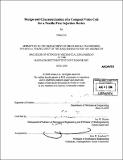Design and characterization of a compact voice coil for a needle-free injection device
Author(s)
Lui, Diana, S.B. Massachusetts Institute of Technology
DownloadFull printable version (2.141Mb)
Other Contributors
Massachusetts Institute of Technology. Dept. of Mechanical Engineering.
Advisor
Ian W. Hunter.
Terms of use
Metadata
Show full item recordAbstract
Conventional needle-free injection (NFI) devices are driven by a pressure source generated by either a compressed spring mechanism or compressed inert gas, which have fixed injection (pressure versus time) profiles. The NFI device developed at the Massachusetts Institute of Technology BioInstrumentation Laboratory (MIT BiLab) is novel in its use of a Lorentz force voice coil actuator as the pressure source. With servo-control, the applied pressure can be adjusted for injection conditions such as skin toughness and injection depth. The focus of this thesis was on designing, building and characterizing a more compact version of the current NFI device. The proposed design features a reduction of the diameter of the voice coil motor by packing empty space with an additional set of magnets. A prototype was built, and benchtop tests were conducted to characterize its force sensitivity, the stability of this force sensitivity, and the jet velocity from the syringe. The force sensitivity was found to be 8.3 N/A, and its consistency was shown to be remarkably stable throughout the stroke of the voice coil. It was found that, with a 200 V input, the voice coil exerted a force of 127 N on the syringe piston, which is equivalent to 12.7 MPa; this pressure produced a jet velocity of 162 m/s out of the syringe.
Description
Thesis (S.B.)--Massachusetts Institute of Technology, Dept. of Mechanical Engineering, 2006. Includes bibliographical references (leaves 42-43).
Date issued
2006Department
Massachusetts Institute of Technology. Department of Mechanical EngineeringPublisher
Massachusetts Institute of Technology
Keywords
Mechanical Engineering.